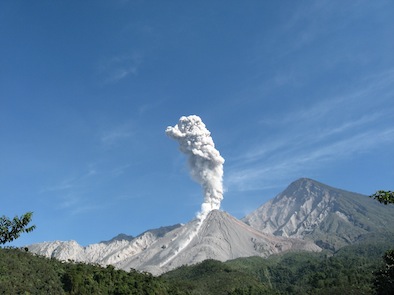Hi Jeannie. Thanks for agreeing to talk to GfGD about your efforts to share your research with the public. To start off, could you tell us a bit about the research you did for your PhD – what were the key findings?
My PhD project focused on the rocks erupted by Santiaguito volcano (Guatemala). Because there had been very little previous research, I started by classifying the rocks and identifying the minerals present. Once I got past those basics, the key findings were that magma evolves in a storage zone in the mid- to lower crust, that magma rigidifies just before it emerges onto the surface, and that erupting lava has been getting gradually less evolved over Santiaguito’s lifetime.
How could this work contribute to future disaster risk reduction?
The results can be used to tailor monitoring efforts to suit this particular volcano – for instance, to allow for the deep magma storage zone and long magma ascent path. I also hope that the work will raise awareness of Santiaguito, in the scientific community and beyond. More research is needed if we want to understand this volcano, but support from outside academia – political, financial, and technical support – is also needed to help the volcano observers properly monitor Santiaguito, and to help the local community to increase their resilience to volcanic hazards.
You have made a great attempt to communicate your research outside of academic journals. Who are your target audience?
My target audience is anyone with an interest in Santiaguito. When I began writing, I wanted it to be something that the volcano observers and civil defence workers could use to inform and educate people; it had to be easy for non-scientists to read, explain the science for those who would be interested, and make the importance of volcano monitoring and community disaster preparedness clear to every reader. As the booklet took shape, I realised that scientists would probably be interested in it too, because it’s easier to read and more complete than my research papers. I did the poster version for people who might want a shorter, more visual format with less science.
How are you making sure that this work is seen by the right people?
Making sure the right people see this work hasn’t been straightforward. I’ve used emailing lists where possible, and I did persuade a couple of influential Twitter users to post a link to the booklet, but I have had to email a lot of people and organizations directly, which has taken time and effort. I am a bit worried that I’ve forgotten someone important! I’m sure some of my emails just got deleted, but I know that other people have been passing the links on to their colleagues and friends or even posting them on other websites, so I didn’t have to do all the work myself.
Did you face any difficulties when translating your thesis into simple language?
I have to translate things into simple language so that I can understand them myself, so writing this booklet was easier for me than writing complex research papers! The hardest thing was leaving out things that were fascinating to me, but wouldn’t have interested anyone else. I did have to delete a lot.
What advice would you give to other geoscientists hoping to communicate their research findings to a wider audience?
My advice is for other geoscientists is do what you can – it isn’t easy, but it is worth it. In my case, my funding covered my research and writing my papers and thesis, but not writing this booklet (or poster). I had to take an administrative job, and wrote the booklet in my spare time. But my research is in the public domain now in a way that never would have happened through scientific journals alone. And I have the satisfaction of knowing that my research is going to be really useful to a lot of different people and organizations; that was always my main reason for doing the research in the first place.
And finally, what next for you?
The response I’ve had to the booklet and poster has been incredibly positive, and it has convinced me that it’s really important to make science available to the non-scientists who really need it (and to anyone else who’s interested). So, I plan to spend the next few months producing some more examples of accessible science, with the help and permission of the original researchers, and looking at what formats work best for non-scientists, e.g. booklet, factsheet, poster, etc. I also want to investigate how self-edited, self-published work can retain it’s integrity, and what can be done to make it easier for geoscientists to make their research accessible to all.
I plan to do more geological research in the future, and I will be putting together some funding applications over the next year or so. I like the idea of creating research opportunities for myself because I have rather specific ideas about the projects I want to do!
It’s great to see good science communication in action. Thanks for talking to us!


Anna Banks
It’s amazing what she did there! It must be very hard dealing with non-scientific, but they are very good addition to your research topic. Citing them could make your thesis more firm and interesting to the panel. The topic itself triggers curiosity that each and everyone who would read it would probably get hooked to it.